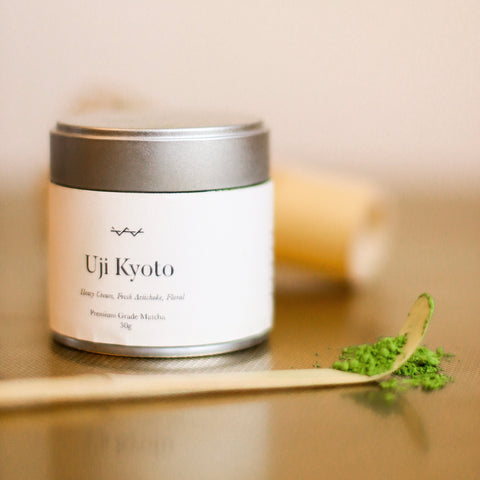Below you will find a few sections aimed at different matcha interpretations. As follows:
a. Traditional matcha recipe (4oz water form)
b. Modern latte recipe (10oz milk form)
c. Notes on process
But first, let’s quickly talk tools. Regardless of which recipe you’re hoping to follow, you’ll need a little gear to really get going. Just as for coffee, there is a somewhat rigid baseline of equipment that, while not technically essential, will be paramount in yielding consistency. Their absence will make matcha preparation more difficult, and we truly recommend investing in them: the peace of mind their application creates is a big feature of the entire matcha experience. We would be sad to see them gone.
So here’s what you should have on hand:
- Matcha Tea powder (follow here for our ceremonial blend, if you're in the market)
- Water, milk, or milk alternative (depending on recipe)
- Cooking or barista scale
- Medium sized, shallow bottomed bowl
- Matcha sifter
- Matcha whisk (chasen)
- A basic way to heat liquid
Okay. Let’s begin.
Traditional Matcha Recipe
1a. Bring water to temperature.
Because matcha is a stone-ground form of green tea, its delicate structure will break down if the water used for brewing is too hot. Bring your kettle somewhere between 160º and 170º for the brew. Anything hotter than this will result in a muddled, bitter cup.
While it takes an extra moment, sifting is a vital step in removing clumps that form in the finely ground tea. The result is a more evenly distributed cup without a surprise layer of green muck at the bottom.
Place the sifter over your matcha bowl (called a chawan traditionally, it can be replaced with any normal IKEA serving bowl). Using a scale underneath the whole setup, weigh out 2 grams of matcha powder into the sifter—roughly two teaspoons worth.

Now, using a spoon (or a chashaku, the traditional bamboo matcha scoop), lightly press the powder through the sifter, using a back and forth motion. Gravity should do most of the work, so you’ll only need to lightly agitate the ground tea.
Matcha sufficiently sifted, pour a small dose of water into your matcha bowl. About 4 ounces should do, or about 120 grams (the same size as a cortado, if that’s another helpful unit). Then comes the satisfying finale.
Delicately grab your matcha whisk and begin to make quick back-and-forth motions, making sure to graze the bottom of the bowl so as to get every last bit of powder mixed. Think of tracing a wide W shape with your whisk, moving slightly horizontal with each pass.

After a short time, the dark green hues will have taken over the whole bowl, and a lightly bubbled froth will appear on the surface. This is the sign that you’ve finished.
Sip, or take it quickly—matcha has been enjoyed in a few different ways throughout Japanese history, so drink it however you like. This more traditional recipe may be somewhat startling if you’ve never tried it before—it’s a much grassier, bitter flavor concentration than its latte counterpart, but you might find it to be as welcome a pick-me-up on those dog days as the sting of a well extracted espresso shot. If you haven’t before, give it a go!
Matcha Latte Recipe
If your palate prefers a richer profile, this matcha latte recipe may be to your liking. Its subdued sweetness combines with the grassy matcha bed for a balanced, modern take on the tradition.

This recipe is our personal cafe favorite. In the shop, we choose to forego the water altogether, and instead create a matcha base using milk, relying on the sifting to ensure proper integration. We find the result of this technique to be a purer set of flavors, though it does require a bit more attention to be paid during the whisking process, as the thicker fats of the milk will encourage the matcha to remain clumped in the corners of the bowl. The procedure is nearly identical to the traditional matcha recipe, with only a few changes necessary:
For this latte, we’ll be using about 10oz of milk, or whatever alternative you prefer. (We love oat milk as much as you do.) Heat whatever dairy or non-dairy beverage you’ve selected to that same 160º to 170º range, making sure to stir evenly to avoid burning any milk to a pot or kettle base.
Sift 2 grams of matcha over your matcha bowl, using a gentle motion with your spoon to encourage the powder through the fine mesh of the sifter.
If you skip this step, the end latte will lack a large majority of the matcha flavor, as the potent green will remain locked away in little clumps that even a vigorous whisk will struggle to infuse into milk. Take care at this step and your final product will truly show it.
Just like the traditional matcha, we are going to pour a small bed of milk first. The amount doesn’t have to be exact, but roughly 3 to 4 ounces works well for us. Somewhere between a third and a half of the total liquid you’ve heated.

Then, think of the W shape once again as you create back-and-forth strokes through the developing matcha. This time, take a bit more care to get the whisk’s bristles along the bottom of the bowl—we want to try and get every last bit of powder we can. When a fine froth appears atop your milk, you’ll know you’ve done your job.
Now we’ve only to combine our ingredients before our latte is born for its short life in this world. If you prefer a touch of sweetness, you might dash a little vanilla syrup in amongst the players. Honey or maple syrup can also be brilliant natural sugar substitutes. We use 1 ounce when sweetening at the cafe.
Stack the matcha with the remaining milk into your cup of choice, and enjoy! The variations on this recipe are numerous, so feel free to explore possibilities.

(As an end note, you can also easily create an iced matcha in much the same manner. Simply skip the heating step, whisking cold instead, and pour over iced at the end. A cocktail shaker can do wonders for this style of integration.)
On Process: An Anecdote
Thank you for taking the time to read through our piece on matcha brewing. I’m Harrison, the one writing this for you, and I wanted to touch briefly on the process of brewing, and how my posture has affected my experience. I’ve learned a lot since the first time I tasted matcha, but I’m still happily surprised by the small states of quiet that often happen when I sit down for another cup. Stopping to think on how young the international export of matcha from Japan really is, it’s hard not to feel grateful to be a part of a western generation with the opportunity to experience something whose life and beauty was previously difficult to come by.
Brewing can be an exercise in remembrance. Throughout Japanese history, a whole culture has evolved around tea’s aid to our inner reflection. Sadō—the Japanese tea ceremony briefly referenced at the beginning of this piece—is a ritualized distillation of this idea (though that’s a real simplification of the tradition’s full ethos).
I lived in Japan for a while, but my understanding of tea ceremony is still relatively surface. My intention here is not to attempt translation of culture—I think that would be an unwise endeavor. However, I wonder if there is not a universal element present in those age-old ceremonies that might be more accessible to us as modern partakers than it may seem from outside peering in.
During my time, I was allowed to stay on the southwestern island of Kyūshū, where a family took me in to live a while, showing me great hospitality and looking after me as I stumbled through cultural studies in the area. At a time of life when I had not yet worked as a barista, they showed me how to brew and drink matcha as they had been taught. Their method was simplified from a traditional ceremony (we were only five gathered at a plain wooden table next to the space heater), but the heart was one of slowing down to partake in something together, to visibly acknowledge how nice our time there was. That moment often comes back to me when I brew matcha back stateside. It’s not a fancy revelation, but something small I try my best to remember when I’m whisking a cup for somebody at our cafe.
I suppose there is no conclusion to that thought trail, but I hope this page might be a reason someone else remembers something they’re grateful for. Perhaps the cup you’ll brew can be like a new signal for reflection, too.
That’s all we have for now. Thank you for reading.

